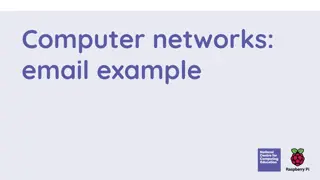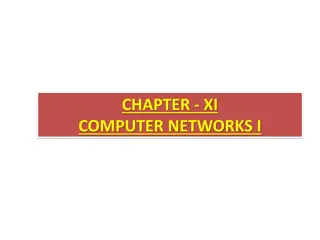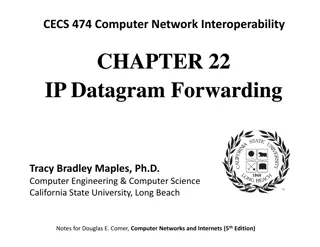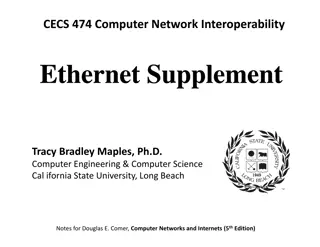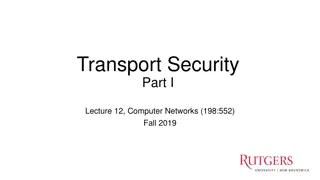Fundamentals of Computer Networks
Explore the essentials of computer networks, covering topics such as DHCP, NAT, IPv6, server operations, and IP address allocation. Understand how DHCP servers control IP address pools and provide network configurations to clients. Learn about address leases for dynamic allocation and how DHCP clients communicate with servers using broadcasts. Delve into the principles of network configurations and the mechanisms behind DHCP protocols.
Download Presentation

Please find below an Image/Link to download the presentation.
The content on the website is provided AS IS for your information and personal use only. It may not be sold, licensed, or shared on other websites without obtaining consent from the author. Download presentation by click this link. If you encounter any issues during the download, it is possible that the publisher has removed the file from their server.
E N D
Presentation Transcript
Networking Potpourri: Plug-n-Play, Next Gen 14-740: Fundamentals of Computer Networks Credit: Bill Nace Material from Computer Networking: A Top Down Approach, 6thedition. J.F. Kurose and K.W. Ross
traceroute DHCP NAT IPv6 14-740: Spring 2017 2
DHCP Dynamic Host Configuration Protocol Client-server mechanism to get config data IP address, DNS server, etc Client is usually a recently-booted host RFC 1531 (1993) replaced BOOTP Obsoleted by RFC 2131(1997) DHCPv6, an IPv6 version in RFC 3315 14-740: Spring 2017 3
Principle of Operation Newly booted client needs configuration details Most important: its own IP address Others: next-hop gateway, subnet mask, DNS server, time servers, static routes, TCP TTL value, etc Broadcasts requests Server, somewhere, responds with details 14-740: Spring 2017 4
DHCP Server Controls a pool of IP addresses And a repository of network details Provides these details upon request or by default Multiple servers possible Also, a single server may serve multiple subnets 14-740: Spring 2017 5
Server: IP Allocation Automatic allocation: A permanent IP address is assigned to the client Dynamic allocation: IP address is assigned for a limited period of time Allows for automatic reuse Manual allocation: Sys admin decides which IP addresses will be assigned to each client 14-740: Spring 2017 6
Leases Used for dynamic allocation Solution for control of when an address can be given to another client Because most clients won t tell the server when they disappear Server allows use of addr for a set period Client will need to reacquire permission before lease period expires 14-740: Spring 2017 7
DHCP Client How does a client who doesn t know anything about the network (like its own IP address) send messages to a DHCP server? Broadcast! Send to 255.255.255.255 Uses UDP, port 67 May get responses from multiple servers 14-740: Spring 2017 9
DHCP Messages Fields include type: discover, offer, request, ack, release xid: Random transaction value chaddr: client hardware identifier MAC or other opaque key siaddr: server s IP address yiaddr: your address options: lots of optional parameters 14-740: Spring 2017 10
Discovery Process All communication is broadcast Thus the funky arrows in our sequence diagram Multiple servers may respond Client chooses whichever offer it wishes DHCP Request / Ack is repeated to renew a lease
Security or lack thereof Unauthorized server Can get client to use your configuration values (i.e. malicious DNS server) Unauthorized client Can get access to the network Can get server to exhaust IP address pool, and thus DOS the subnet 14-740: Spring 2017 12
The Bottom Line DHCP is critical for plug and play network capabilities Saves administrative hassles ... and errors from mis-configured values Finding which host is re-using an IP address can be a struggle, for instance 14-740: Spring 2017 13
Network Address Translation Mechanism to simplify IP address allocation Basic idea: Router appears as a single IP address to the world, but manages a complete subnet with many hosts Maps one address space into another Also called IP masquerading or IP spoofing 14-740: Spring 2017 15
NAT Benefits Work-around to the impending exhaustion of IP addresses Entire networks can operate with an allocation of just a single IP address Also allows for simple address allocation for the subnet No need to contact the ISP to add additional end hosts Security : internal network structure obscured 14-740: Spring 2017 16
Mechanics Hosts on private network use non-routable IP addresses Defined in RFC 1918 10.0.0.0/8 prefix 172.16.0.0/12 prefix 192.168.0.0/16 prefix Packets restricted to the private subnet Why? xkcd.com/742 14-740: Spring 2017 17
Mechanics (2) Router shows a single external IP address Translation table maps external IP / port combinations to internal IP / port Rewrites all packets in each direction, changing IP / port based on translation table Other fixes also needed to the packet 14-740: Spring 2017 18
Example Operations vary based on contents of table -- other possibilities exist! 14-740: Spring 2017 19
NAT Versions Depending on contents of the table, may get differing effects Basic NAT: IP address translation only Port Address Trans: IP and port translations Source NAT: rewrites sender s IP/Port Dest NAT: rewrites destination s IP/Port Symmetric NAT: mapping corresponds to {send, rcvr} pair Requests sent from same sender but to different destinations get different mappings only an external receiver can reply 14-740: Spring 2017 20
Packet Fix-up Router must do more than simply change address/port values Fix checksums Some application protocols need fixing FTP and SIP send IP/port values in the data stream of the control channel Must reassemble fragmented packets Especially problematic if encryption has been applied 14-740: Spring 2017 21
Port Forwarding Translation table is normally initialized by internal traffic Which means no external host can initiate communication One solution: connection reversal, involves ongoing communication with external server Port forwarding specifies values ahead of time Example: BitTorrent traffic will be handled by a particular internal host with addr intIP, so forward all traffic to extIP:6881 to intIP:6881 14-740: Spring 2017 22
Purists love this, right? Objection 1: IPv6 should be used to solve addressing problem Believe NAT has staved off adoption of IPv6 Objection 2: Violates end-to-end principle Objection 3: Routers shouldn t process packets higher than network layer Objection 4: Using port numbers to address hosts 14-740: Spring 2017 24
Purpose: More Addresses Early 90s: "IP addr exhaustion coming" How can that be? 232is 4 Billion hosts? 1996: 100% Class A, 62% Class B, 37% Class C addresses assigned 2011: IANA allocated last remaining blocks to regional registries 14-740: Spring 2017 26
While we're at it... Bigger addresses mean breaking the IPv4 header, so may as well do some other stuff at the same time... Streamline the header Improve option processing Self-configuration BTW, breaking the header format means everyone (all hosts and all routers) needs to change -- leading to slow adoption rate 14-740: Spring 2017 27
IPv6 Addresses 128 bit addresses 340 billion, billion, billion, billion addrs 2128= 3.4 x 1038 That should be enough for a while xkcd.com/865/ 14-740: Spring 2017 28
Address Notation Write IPv6 addresses using 4 hex digit groups, separated by colons Leading zeros are dropped, largest string of contiguous zeros are not written 1987:A456:2B2B:1234:BEEF:5678:CAFE:D82F 0124:A245:0000:0000:0000:0000:0001:0023 124:A245::1:23 14-740: Spring 2017 29
Address Classes IPv6 Addresses are classless, like CIDR Some addresses are special :: (all zeros) is special (unspecified) ::1 is for loopback Starts with 1111 1111 multicast Starting with 1111 1110 10 link-local more on this in a minute 14-740: Spring 2017 30
Header Changes IPv4 Header
IPv6 Header Version 0110 (i.e. 6) Traffic Class, Flow Label Used to distinguish (give priority to) "flows" of data No definition of how to use Payload Length (in bytes) 14-740: Spring 2017 32
IPv6 Header Next Header: specifies the type of the data Is it UDP? 17, TCP? 6 Same values and purpose as IPv4's Upper Layer Protocol field Or, is it an options field? Specifies the type of an options header placed at the beginning of payload Options headers may be chained, last one specifies next header value for payload 14-740: Spring 2017 33
IPv6 Header Hop Limit: Renamed version of IPv4's TTL Src, Dest Addresses 128 bit, so they take up a large portion of header Total header size: 40 bytes 14-740: Spring 2017 34
Configuration Process of getting an IP address (and other data) to a newly booted end host IP address needs to be unique Often has no other requirement A printer, for instance Autoconfiguration is then possible 14-740: Spring 2017 36
Autoconfiguration Host wishing configuration can choose an IPv6 address for themselves... ... as long as they can guarantee it is unique But, most hosts already have a "guaranteed to be unique number" built into their link-layer Ethernet MAC address, for instance 14-740: Spring 2017 37
IPv6 Autoconfiguration Stateless Autoconfiguration Use Link-local address prefix (1111 1110 10), ... ... followed by some zeros, ... ... followed by Ethernet MAC (48 bits) Can be followed with Neighbor Discovery Protocol (NDP) broadcast messages (RFC 4861) to find network prefix IP addresses, next-hop routers, DNS servers, etc Stateful Configuration: DHCPv6 exists (RFC 3315) 14-740: Spring 2017 38
Lesson Objectives Now, you should be able to: describe DHCP, including information carried, methods of communication, leases, message format and the discovery process describe NAT, including benefits / objections, operations and port forwarding describe situations where NAT needs to modify values other than IP address and TCP/UDP port fields 14-740: Fall 2017 39
You should be able to: describe IPv6, including differences with IPv4, benefits, datagram format, and address notation describe IPv6 address autoconfiguration




